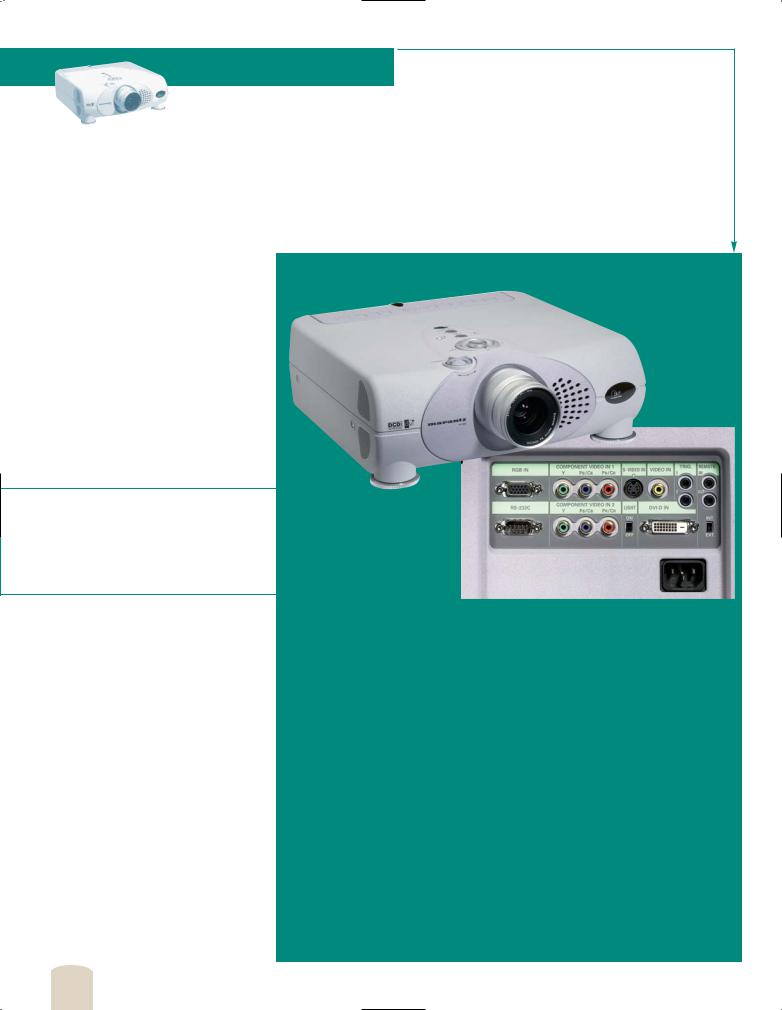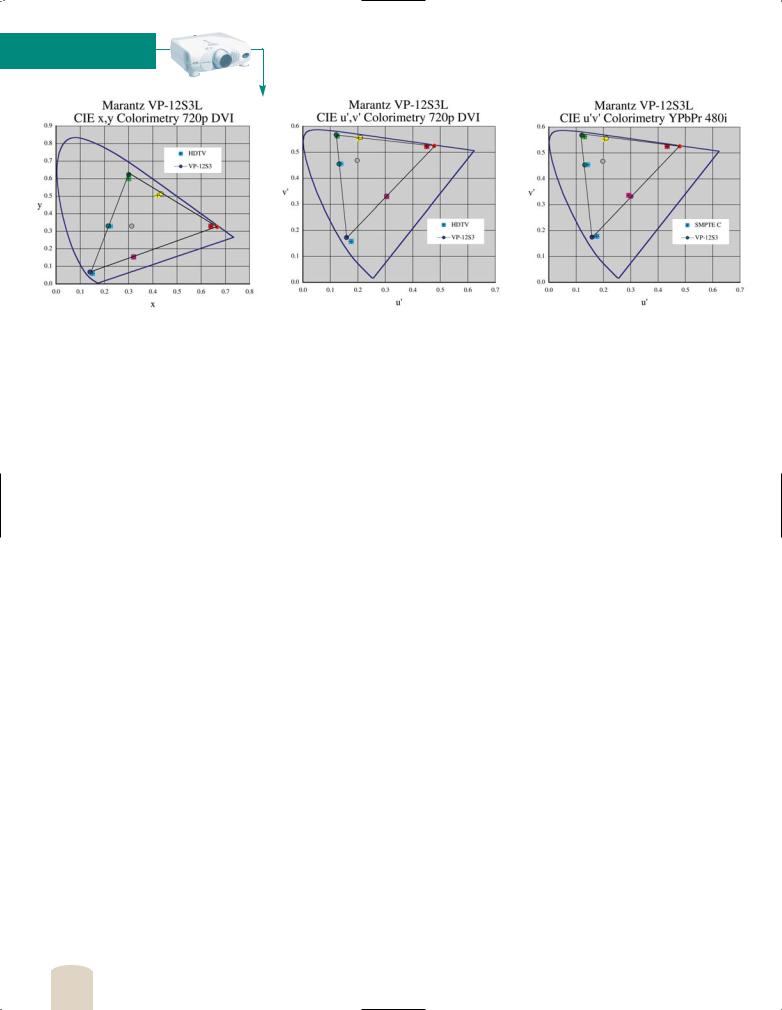Marantz VP-12-S-3 User Manual

Equipment
Review
Marantz VP-12S3L
High -Performance HD2+ DLP™ Video Projector
G R E G R O G E R S
Third-Generation
Technology Enhances
Picture Quality
The Marantz VP-12S3 is the company’s third-generation 720p single-chip DLP projector. It features new technology to increase contrast, lower black levels, and automatically calibrate its gray scale. There are short throw (VP-12S3 - $12,500) and long throw (VP-12S3L - $16,000) versions of the projector to accommodate different room sizes and placement requirements. A VP12S3L was provided for this review.
“I was particularly impressed by the color accuracy and the brilliance of color detail on network broadcasts and D-Theater movies”
Innovation
The VP-12S3 utilizes Texas Instruments’ HD2+ Digital Light Processing™ technology, a 7-segment 5x-speed color wheel, and custom Minolta optics with a remote-controlled twoposition iris that dramatically improves the contrast ratio and black level, compared to previous generation HD2 DLP projectors. In addition, the 200-watt SHP projection lamp is now DC powered to make it less prone to flicker.
The projector’s most innovative new feature is a unique gray scale auto-calibration system. Each projector includes a color analyzer pod that temporarily snaps over the lens like a lens cap. The auto calibration system generates appropriate test patterns and reads data from the color analyzer pod through a cable that attaches to the rear panel RS-232 port. The projector also incorporates a color correction filter (ORCA™) to remove excess yellow from the light that passes through the color wheel. A more neutral white light is said to improve the color palette accuracy and the green primary color in particular.
Marantz VP-12S3L High-Performance HD2+ DLP™ Video Projector
Specifications:
Texas Instruments HD2+ Digital Light Processing™ |
6 Picture Modes: Theater, Standard, Dynamic, |
Technology |
User A, User B, User C |
High Definition 1280 x 720 DMD™ Semiconductor |
5 Preset User Gammas |
Lamp: 200 W SHP DC Powered |
18 Picture Memories |
Lens: f: 26.5 to 30.7 / F: 3.0 - F:5.0 |
4 Aspect Modes |
Contrast Ratio: > 3800:1 |
5 Color Temperatures |
Light Output: > 700 ANSI LUMEN Typical |
Black Level Selection |
Brightness Uniformity: 90% |
Economy Lamp Mode |
Long Life Lamp: (Average 2000 Hours) |
No Light Leakage (Double Sealed Cabinet |
|
Structure) |
Video Inputs |
Extremely Quiet (Noise Canceling Construction, |
Composite Video:1 (RCA) |
Sealed Color Wheel Motor) |
Y/C: 1 (S-Video) |
Power Requirement AC 100-120 V / 220-240 V, |
Component: NTSC/ATSC 2 (3x RCA) |
50/60 Hz |
RGB/HD: 1 (VGA D-Sub 15) |
Power Consumption: < 300 W |
DVI With HDCP: 1 (29 Digital Pin) |
Dimensions (WDH In Inches): 15 15/16 x 18 9/16 |
|
x 5 3/16 (excluding feet) |
In/Outputs |
Weight (In Pounds): 26.1 |
RS232C: 1 (D-Sub 9) |
Price: VP-12S3 $12,500 (short throw lens) |
RC-5: 2 (3.5 mm mini) |
VP-12S3L $16,000 (long throw lens) |
DC Trigger: 2 (3.5 mm mini) |
|
|
Manufactured In Japan For: |
Features |
|
Lens Up/Down Shift |
Marantz America, Inc. |
Adjustable Iris |
1100 Maplewood Drive |
Video Processing Using Faroudja® Processing |
Itasca, Illinois 60143 |
with DCDi™ Enhancement |
Tel: 630 741 0300 |
2-3 Pulldown Progressive Scan Film Detection |
www.marantz.com |
10-bit Digital Gamma Processing |
|
Horizontal and Vertical Keystone Correction |
|
36 Widescreen Review • Issue 84 • May 2004 |
Page 1/7 |

Equipment
Review
Appearance
The projector has a light gray case with a sparkly metal-flake finish. A somewhat darker bezel surrounds the larger than normal lens assembly, which is slightly offset from the center of the projector. The fans exhaust warm air through the front bezel. A manual lens shift dial is located on top of the case, along with a set of operating controls. All inputs are on the recessed rear panel.
Setup
A 16:9 (1.78:1) screen should be used to match the projector’s native aspect ratio. With a 100-inch diagonal (87 3/16-inch x 49-inch) screen, the short throw Minolta zoom lens provides a lens-to-screen throw distance of between 10 feet 9 inches and 12 feet 6 inches. The long throw zoom lens provides a throw distance of between 16 feet 8 inches and 22 feet 7 inches. Focus and zoom are manual adjustments—not available from the remote control.
The mechanical lens shift function permits the center of the lens to be mounted anywhere between the top and bottom edge of the screen, regardless of whether the projector is ceiling mounted or table mounted. The projector can be tilted if it must be located above or below the screen, but this will cause the picture to keystone. Electronic Keystone Correction can be used to restore the image to a rectangle, but keystone correction produces moiré patterns on closely spaced lines, so it should be avoided if possible.
Connections
The rear panel has six video inputs— one composite (RCA connector), one S- video (4-pin mini-DIN), two YPbPr (RCA connectors), one RGB (15-pin D-sub), and a DVI-D input. The YPbPr component video inputs accept standard-definition or highdefinition signals. The RGB input accepts signals with positive or negative HV sync, but not sync on green.
The DVI-D input, which includes HDCP (High-Definition Content Protection), can be configured in a menu to accept digital RGB or YCbCr signals. The latter can be set for standard or high-definition color decoding. You can select the Normal mode for DVI signals with RGB-Video levels (black at digital code 16 and 100 IRE at 235), or the Extend mode for RGB-PC levels (black at 0 and 100 IRE at 255). The black level is switched correctly, but you will want to re-adjust the contrast levels if you switch signal types.
The YPbPr inputs are compatible with 480i/p, 540p, 576i/p, 720p, 1035i, and 1080i
video formats. In addition to the usual 50, 59.94, and 60 Hz field and frame rates, the projector also displays 48 Hz 720p and 1080i signals at their native vertical rates. (I wasn’t able to try that feature.) The analog RGB input is compatible with the same video formats, and 60 Hz PC display formats up to 1024 x 768. According to the manual, PC formats at other vertical rates will be accepted, but not displayed properly. The DVI digital input accepts the same video formats and 60 Hz PC formats.
The rear panel includes an RS-232C control port, and Remote Control In and Out jacks for connection to a Marantz audio component. There are also two 12V Trigger output terminals. One is active whenever the projector is turned on, and the user can specify which aspect ratios enable the other 12V output to control screen masks.
The rear panel also includes a standard three-prong power cable socket and a light switch that illuminates the rear panel for changing cables in a dark room. That much appreciated feature even works when the projector is in standby mode.
Controls
The slender 1.75-inch-wide remote control is logically laid out, but only seven of the 25 buttons are backlit. Those include the Menu, V-Mute (picture mute), Input, Aspect, Pattern, Standby, and Power On buttons. There are also six dedicated input buttons, four Aspect Ratio buttons, and four buttons that select Picture Modes. Onscreen menu items are navigated and selected with a tilting cursor-pad button. There are also buttons for changing the deinterlacing mode and displaying status information.
The Standby button is an annoying operator trap that immediately turns off the projection lamp without asking for conformation. If it is pressed accidentally you must wait for the entire cooling off period before the projector can be turned back on again.
The top of the projector includes an alternate set of buttons for on-screen menu navigation, input selection, the focus pattern, and Power On/Standby. There are also Warning/Lamp, Power, and Standby indicators. The maximum lamp life is 2,000 hours, but Marantz recommends replacing the lamp after 1,000 hours. The lamp is user replaceable.
On-Screen Menus
The on-screen menus are arranged in hierarchical levels. The Main menu includes Picture Adjust, Setting, System, Display, Config, Trigger 2, and Preset.
The Picture Adjust submenu provides
Contrast, Brightness, Color (Saturation), Tint (Hue), Sharpness, Noise Reduction, Color Temperature, and Fine Menu. When a variable Picture Adjust item is selected, the menu disappears and is replaced by a single bar graph and numerical value near the bottom center of the screen, which makes it easier to perform adjustments without part of the picture being covered. When the adjustment is completed the menu reappears. The Picture Adjust items change depending on the input and the signal format. For example, the Tint and Noise Reduction controls are only available for composite and S-video signals.
The Fine Menu item produces a submenu that includes Luminance, Chrominance, Sub Control, and Miscellaneous. The first two items provide a large number of adjustments for detail and edge enhancement. I’ll discuss those in a separate section. The Sub Control item produces a menu that includes red, green, and blue (RGB) Contrast and Bright controls, which are equivalent to the usual RGB Gain and Bias controls for adjusting color temperature and grayscale tracking. There are also Clamp Width and Clamp Position adjustments for analog RGB signals, which can be useful for signals that have non-standard timing. The Miscellaneous item produces a menu that includes DCDi™ (On/Off), CCS (cross color suppression) (On/Off), FRC (frame rate conversion) (Auto/On), and Sharpness Filter (0-4).
The Setting submenu includes Lamp mode (High/Low), High Bright (On/Off), Aspect Ratio, VCR mode (On/Off), Cinema (Auto/Off), Iris (5.0/3.0), and Black Setup. The Lamp mode changes the lamp brightness by switching the lamp power. The High Bright mode increases brightness by producing an overly blue gray scale and should be avoided for critical viewing. The VCR mode is for poor quality video sources. It forces the projector to use intra-field vertical interpolation for deinterlacing and should be left off for DVDs and most broadcast video. The Cinema mode enables inverse-telecine deinterlacing for standarddefinition film sources. The F5.0 Iris mode maximizes the contrast ratio at the expense of picture brightness. Black level setup selects a 0 IRE or 7.5 IRE black level for analog input signals, and RGB-video or RGB-PC levels for DVI signals.
The System submenu selects the signal format (Auto, NTSC, PAL, 480i, 720p, etc.) for each input, but the Auto value worked fine for all of my sources. This menu also provides RGB or YCbCr (standard or high definition) selection for the DVI input.
The Display submenu includes Vertical and Horizontal Keystone, Auto Adjust, Vertical and Horizontal Size and Position, and Phase.
38 Widescreen Review • Issue 84 • May 2004 |
Page 2/7 |

Equipment
Review
Auto Adjust determines the Size, Position and Phase settings automatically for analog RGB signals. The Config submenu includes Auto Power Off, OSD Position, Language (6 choices), Ceiling (mount) (On/Off), Rear (projection)
(On/Off), Color Temp Calibration, Reset Lamp Life, and Reset All. The Trigger 2 submenu selects the Aspect Ratios that enable the 12V Trigger 2 output terminal.
The Preset submenu selects the Picture Mode (Theater, Standard, Dynamic, User A/B/C), Index (1, 2, 3, Default), and Gamma (A, B, C, D, E, a, b, c). The Gamma setting can only be selected for the User picture modes.
Lamp Mode
The Lamp mode selects the brightness of projection lamp. This is one of the quietest projectors I have measured. In the High Lamp mode, the fan noise measured only 51 dB, C-weighted at 12 inches from the front (exhaust side) of the projector. The noise level dropped below the 50 dB sensitivity of my sound level meter in the Low Lamp mode.
Picture Modes
Each of the six picture modes (Theater, Standard, Dynamic, User A/B/C) stores three sets (Index 1-3) of Picture Adjust settings and a gamma mode. These are global settings that can be used with any input. When an input is switched, the picture mode and index last used with that input are restored.
Gamma
There are eight preset gamma curves (A-E, a-c). The gamma curves for the Theater, Standard, and Dynamic picture modes are ‘a’, ‘b,’ and ‘c’ respectively. Any of the eight gamma curves can be selected for the User picture modes.
The ‘A’ and ‘B’ gamma curve values are relatively constant (about 1.62 and 1.73
respectively) from 10-60 IRE and then fall off at higher signal levels. The ‘C’, ‘D,’ and ‘E’ gamma curve values rise below 20 IRE (to about 2.02, 2.09, and 2.11 at 10 IRE) and are relatively constant (about 1.85, 1.75, and 1.85) to about 70 IRE before falling off. Therefore, dark image areas appear darker as the gamma changes from ‘A’ to ‘E.’ The ‘a’ curve is much like ‘A’ (about 1.64) with a slight gamma increase at the dark end. The ‘b’ curve is relatively flat with an average gamma of about 1.83, and the ‘c’ curve is nearly the same as ‘C’ without falling off at the bright end.
These are all unusually low gamma values. A display gamma of 2.2 is required to produce a system gamma of 1.0, and as I’ve indicated in previous reviews a system gamma of 1.1 to 1.2 is advantageous when viewing a picture with a dark surround. That requires a display gamma of 2.45 to 2.67. I prefer a display gamma of about 2.5.
On this projector I preferred the ‘c’ gamma curve even though ‘E’ had a higher gamma at 10 IRE. I wasn’t sure why until I realized that the brightest parts of the picture (above 70 IRE) were compressed (too bright) because the gamma falls off at the top of the ‘E’ curve. That bothered me more than the additional brightness at the dark end of the gamma curve, which makes shadow details more visible, but leaves some images a bit flat with too little contrast.
There are no controls to modify the preset gamma curves, but the manual mentions that special PC software can be used to create custom curves. That software was not available at time of the review.
Aspect Ratios
There are four Aspect (ratio) Modes— Full, Normal, Zoom, and Through. The Full mode is used to display 16:9 sources— HDTV (720p/1080i) and 16:9 (anamorphic) DVDs. The Normal mode is used to correctly display full frame 4:3 (1.33:1) pictures in
the center of a 16:9 screen with black sidebars. The Zoom mode is used to display 4:3 letterboxed pictures by expanding the image proportionally in the vertical and horizontal directions to fill the width of the screen. The Through mode displays any format with less than 720 vertical lines (or pixels) in its native pixel resolution without scaling the image. There is no mode to nonlinearly stretch a 4:3 image to fill the screen.
Gray Scale
A custom color analyzer pod is included to automatically calibrate the projector’s grayscale. The color analyzer pod snaps over the lens like a lens cap, and has a cable that plugs into the RS-232 port on the projector’s rear panel. To perform an automatic calibration the user only needs to initialize the sensor, center the lens shift adjustment, snap the color analyzer over the lens, and press a button. About 5 minutes later the process is complete.
After running the auto calibration I measured a gray scale of 6601K +267/-8K from 20-100 IRE. There was a 5-8 dE (delta-E) deviation from D65 (x = 0.3127, y = 0.329) over that range. The color temperature increased to 7408K at 10 IRE with a dE of 17.
I manually calibrated the Color Temperature and gray scale tracking to match D65 using the red, green, and blue Contrast (gain) and Bright (offset) adjustments in the Fine Picture menu. The manually calibrated gray scale measured 6500K +47/-49K from 20-100 IRE, and 6702 at 10 IRE. More importantly, the gray scale deviation from D65 measured just 0-2 dE from 20-100 IRE, and 4 dE at 10 IRE.
Black Level And
Contrast Ratio
An AccuPel HDG-3000 Calibration generator (www.accupel.com) was used to generate test patterns for measuring grayscale,
40 Widescreen Review • Issue 84 • May 2004 |
Page 3/7 |
